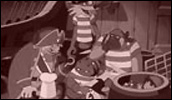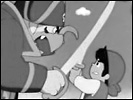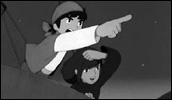Animal Treasure Island
- Year
- 1971
- Original title
- Doubutsu Takarajima
- Japanese title
- どうぶつ宝島
- Director
- Cast
- Running time
- 78 minutes
- Published
- 7 March 2006



by Jasper Sharp
While numerous pundits and industry bigwigs might like to point to alien storytelling traditions and baggy narratives, I can't help thinking that there are rather more simple reasons for the comparative lack of take-off of Studio Ghibli's Spirited Away and Howl's Moving Castle at the box offices of the English-language world compared with their domestic successes. Certainly if the reactions of my wee nephew and niece are anything to go by, it has little to do with the intrinsic qualities of the films in question. Quite the opposite in fact. While Robots' knowing adult wise-cracking went right other their heads and the chaotic flurry of clinically-modeled CG action kept me distanced from the characters and story and left me with nothing more than a throbbing head, I was pleasantly surprised at how emotionally engaged they became in the world of Howl's. No, if there's any problem, it has to be one of invisibility. When was the last time you saw a TV puff piece or a nationwide fast-food tie-in campaign for a Disney-released Ghibli movie?
This year's been a pretty good one to test the full range of children's endurance with regards to the sheer variety of animation put out there in theatres and on DVD, and an enlightening one too. At the end of it, I've come to the conclusion that, while interesting characters are a definite boon, kids below the age of ten will pretty much watch anything if it is fast-paced and colorful enough (though I've yet to test my hypothesis to the full by bringing the Stan Brakhage DVD down from the shelves!)
All of this is just a preamble to say that Animal Treasure Island was a big hit with the youngsters, and thankfully Discotek Media, the company releasing it, have been judicious enough to include an English dub track along with the subs - something that Optimum would have been well-advised to do with their recent release of The Little Norse Prince. Historically speaking, both of these titles are vital releases in helping to defog the nebulous world of pre-80s anime, giving a clearer insight into the modus operandi of Japan's oldest and largest animation studio in their attempts to reach out to a global audience in the 60s and 70s. Toei Animation (Toei Doga) had a vital part in fostering Ghibli's founders Isao Takahata and Hayao Miyazaki, the twin talents that have gone on to become the ambassadors of the nation's animation. The Little Norse Prince gave Takahata his first stab at directing a feature-length animation, while Hayao Miyazaki played a vital behind-the-scenes role in the story and designs for Animal Treasure Island.
There's not many a pirate yarn that can't trace back its lineage to Robert Louis Stevenson's Treasure Island (1883), a rollicking tale of adventure on the high seas featuring Jim, a fanciful young lackey working at his parents' harbor-side inn who finds himself pitted against a surly rabble of salty seadogs eager to get their hands on the map whose X marks the spot where a legendary stash of treasure is buried.
Aimed at a pre-teen audience, it would be a little peevish to point out the lack of complete fidelity to the familiar story from which Toei Doga's retelling owes its name. The main departure is in the depiction of the cutlass and musket-wielding menagerie who cross paths with Jim and his entourage, which includes his bespectacled mouse friend Gran and stowaway baby brother Baboo, after they set out with the crucial map in hand (bequeathed by the mysterious peg-legged Captain Flint in the opening moments) across a beautiful pea-green ocean in a souped-up wooden barrel. Shortly after their first encounter with the porcine Long John Silver, they are clapped in irons in an Arabian Nights-styled jail guarded by a fez-wearing hippo, where they are joined by Captain Flint's granddaughter Kathy and, later on, by a sympathetic pirate walrus named Otto.
Comparisons with Disney's work around this time are apt, as it is clear that from their first feature-length colour animation Legend of the White Serpent (Hakujaden, 1958) onwards through works such as Journey to the West (1960) and Puss in Boots (Nagagutsu o Haita Neko, 1969), the company were actively pursuing international markets, and were increasingly subduing the oriental flavor of their early works (which had been drawn from Chinese folk sources, rather than European ones).
Animal Treasure Island was released at around the same time as Disney's Aristocats (1970) and Robin Hood (1973, both directed by Wolfgang Reitherman) to mark the twentieth anniversary of the founding of the studios. The obvious differences in approach are best attributed to budget, with an emphasis more on the crack-paced plotting and colourful slapstick cartoon comedy-action sequences over the minutely observed character animations that mark out the best of Disney.
All of this makes the film best suited for children, though it has to be said there's a great deal of fun to be had for viewers of all ages. But for older anime fans, the film's main point of interest is in its early employment of Ghibli's Hayao Miyazaki, working in the capacity of story consultant and key animator, a role he also took on director Ikeda's previous feature Flying Phantom Ship (Sora Tobu Yureisen, 1969). Delving even further back into history, Ikeda also helmed Toei's TV series Ken the Wolf Boy (Okami Shonen Ken, 1963), on which Miyazaki first worked in the lowly capacity of an in-betweener.